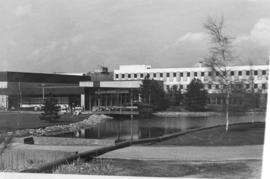Zone d'identification
Cote
Titre
Date(s)
- 1970-2004 (Production)
Niveau de description
Collection
Étendue matérielle et support
13 photographs, 1 cm textual records and other materials
Zone du contexte
Nom du producteur
Histoire administrative
BCIT Archives exists to acquire, preserve, organize and provide access to the materials that uphold the legal and historical record of BCIT and the BCIT community. The need for establishing an Archives at BCIT was acknowledged and argued for by Library and Records Management staff starting in 2002. The BCIT Archives was first professionally staffed in 2005.
Nom du producteur
Histoire administrative
The British Columbia Institute of Technology (BCIT) officially opened October 4, 1964. Areas of study available were: Engineering, Health and Business.
On January 17th, 1958, the Minister of Education for the Province of British Columbia, the Hon. L. R. Petersen announced the appointment of the Royal Commission on Education for the Province of British Columbia for the “purpose of reviewing and assessing the educational system with he aim of improving its effectiveness in the light of world conditions and providing guidance for its future development.” Concurrent with the Commissions inquiry the Provincial Curriculum Advisory Board of the Department of Education appointed a committee directed by Mr. D. E. Bridge of the Vocational Training Branch of the Department of Labour, Ottawa to survey “The Need for Advanced Technical and Vocational Training in British Columbia.” As a result of the Royal Commission on Education, the Bridge Report and financial assistance from the Federal Government, an Advisory Council was formed early 1961 to begin planning what would become the British Columbia Institute of Technology. Dr. J. English, Deputy Minister and Superintendent of Education was appointed chairman and Mr. J. S. White, Director of Technical and Vocational Education, vice-chair.
Until 1974 BCIT was directly controlled and funded by the B.C. Department of Education, in partnership with an Advisory Council chosen from business and industry. The council appointed the Principal of BCIT as the Chief Executive Officer of the Institute. Two Vice-Principals were responsible for Administration and the growing Extension Division. The three divisions of Engineering, Business and Health were managed by three Directors reporting directly to the Principal. The Council formed seventeen advisory committees which met at least twice a year and advised Technology Heads at BCIT about the effectiveness of the programs being taught, opportunities for employment and updates in the industry. Recommendations went through the Principal who carried them to the main Advisory Council. In 1963, the Department of Education took a radical departure from existing government policy and allowed the BC Civil Service Commission to delegate responsibility for selecting teaching staff to the Institute, via the Advisory Council and Principal.
In 1972, the Minister of Education established a task force to recommend future directions for BCIT. A more autonomous relationship developed between the provincial government and BCIT with the passage of the British Columbia Institute of Technology Act on July 4, 1974. The Act established a new system of governance for BCIT under a fifteen–person Board of Governors. Under Section 11 (3) of the BCIT Act the Principal was required to submit an Annual Report to the Board of Governors for the educational year. The position of Principal was expanded to encompass linking functions both between the Board of Governors and BCIT, and between BCIT and the external community. The Principal assumed the responsibility of implementing Board policy and administering the budget; she also served as the chief means of mobilizing the institute’s resources in recognizing and clarifying issues and expediting decision making. At the same time, three Executive Director positions were created in the areas of Technical Education; Administration; and Personnel and Information Services and Student Services, in order that BCIT could effectively carry on day-to-day operations while implementing a variety of administrative systems. With the Directors of the five Educational Divisions, the Bursar, the Registrar, and the Coordinator of Planning Services, the Executive Directors were members of an Executive Committee, a consultative body which advised the Principal and served as a channel of communication between the Chief Executive Officer and the institutes staff, students and faculty.
In 1978 the Boards of the Pacific Vocational Institute (PVI) and BCIT established a Joint Boards Committee, enhancing the relationship of the neighbours and providing a forum for cooperation between the institutions in matters of mutual interest. On May 31, 1985, the Honourable John H. Heinrich, then Minister of Education announced the decision to amalgamate the Pacific Vocational Institute (PVI) and the British Columbia Institute of Technology. The merger culminated in a new organizational structure, a mission statement and a set of corporate objectives for BCIT. The expanded mandate for the new institution included:
• A centre of excellence for the trades
• The development of new technology programs
• The development of post diploma programs
• The development of bridging programs from trades to technology
The official merger took place on April 1, 1986. In July 1985, the President and the Board of Governors appointed Drug Svetic Vice President, Education; Duncan McPherson Vice President, Finance; Len McNeely Vice President, Administration; and Peter Jones Vice President, Student Services and Educational Support. The reorganization of BCIT’s educational division resulted five schools, adding an Executive Director of Trades Training and the introduction of an associate dean structure.
In 2004, BCIT's governing legislation became the College and Institute Act, RSBC 1996, ch. 5 (2). Under this Act, the President is defined as BCIT's Chief Executive Office, with the duty to “supervise and direct subject to bylaws, the instructional, administrative and other staff of the institution and exercise powers and perform duties assigned to the president by the board.” The President is to report to the Board annually on the progress of the Institute, make recommendations, and advise the Board on all matters concerning the operation of the Institute.
Histoire archivistique
Source immédiate d'acquisition ou de transfert
Zone du contenu et de la structure
Portée et contenu
Collection includes items relevant to the history of Guichon Creek (also known as Kyle Creek) digitized by the BCIT Archives. Many items in this collection are edited, color-corrected or otherwise enhanced digital copies that exist in the BCIT Archives Photograph Collection 23.
Collection also includes ephemera from BC Rivers Day and World Rivers Day.
Évaluation, élimination et calendrier de conservation
Accroissements
Mode de classement
Zone des conditions d'accès et d'utilisation
Conditions d’accès
These images are provided for research and reference use only. Please contact the BCIT Archives for permission to publish, copy or otherwise use this material.
Conditions de reproduction
Langue des documents
Écriture des documents
Notes de langue et graphie
Caractéristiques matérielle et contraintes techniques
Instruments de recherche
Zone des sources complémentaires
Existence et lieu de conservation des originaux
Existence et lieu de conservation des copies
Unités de description associées
Zone des notes
Note
Identifiant(s) alternatif(s)
Mots-clés
Mots-clés - Sujets
Mots-clés - Lieux
Mots-clés - Noms
Mots-clés - Genre
Zone du contrôle de la description
Identifiant de la description
Règles et/ou conventions utilisées
Statut
Niveau de détail
Dates de production, de révision, de suppression
C. McLellan, created 2015-12-17
Langue(s)
Écriture(s)
Sources
Objet numérique - métadonnées
Nom du fichier
Cover-Image_a001172.tif
Latitude
Longitude
Type de support
Image
Type MIME
image/tiff














